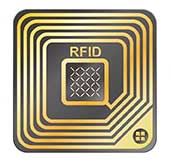Radio Frequency Identification in Packaging
PACKAGING
The implementation of radio frequency identification (RFID) in consumer product industries has primarily been dedicated to manufacturer and retailer transactions. RFID applications that do target consumers are generally focused on marketing efforts and hindered by the actual signaler/ tag cost versus benefit imbalance. Although some retailers have driven RFID label use, consumer product groups (CPGs) have traditionally paid tag costs. Savings have been passed along to retailers and distributors but not necessarily to consumers.
 The Technology
The Technology
The three elements of an RFID system are a tag, a reader, and a database. RFID tags are electronic devices that receive, store, and transmit data such as serial numbers, manufacturer codes, country of origin, recipes, nutritional information, expiration dates, etc. An RFID reader uses a radio frequency transmitter and receiver, control unit, and a memory unit to gain access to stored information for authentication. Antennae attached to both readers and tags enable the wireless exchange of information between readers and tags.
In the consumer products industry, passive RFID tags, which do not have batteries, are used instead of active (with batteries) RFID tags and semi-passive (partially battery powered) RFID tags. Readers can be fixed or mobile. Products with RFIDs can be monitored from suppliers, converters, CPGs, distributors, retailers, and consumers to the post-consumer environment. RFID developments to increase CPG use have focused on decreasing size (thicknesses between 20 μm and 50 μm), environmental resistance (resistant to 400°F and 60 psi), and metal and liquid compatibility. Refined tags and mobile or stationary readers enable the reading of RFID tags without direct line of sight as well as a rapid information exchange and 99.9% reliability. The small size, environmental resistance, and product compatibility make RFID viable for the transmission of consumer product information.
Out-of-Stock Items
Manufacturer-retailer interfaces using RFID have achieved cost savings and addressed logistical issues associated with out-of-stock merchandise (OOS) and diversion. OOS and diversion with limited RFID application has had some success, but greater success can be achieved with a consumer focus on sustainability and safety. OOS results in either lost sales for CPGs and/ or retailers. The impact can be far reaching since OOS is prevalent during seasonal peaks, sales, advertising campaigns, weekends, product/ package conversions, and new product introductions. As a result, costly marketing functions are wasted if the product is not available for purchase. The central issue is resolving product location, but where RFID has been implemented, confused and disjointed successes in reducing OOS exist due to a focus on CPG-retailer interfaces. Since OOS impacts packaging suppliers and converters via lost sales of package materials, these entities may also benefit from the use of RFID. However, such entities and the remainder of the value chain have not been involved in increasing the viability and benefits of RFIDs. And despite indications from retailers, CPGs have been unable to fully implement retail-driven RFID programs. Retailers unwilling to share information have likely hindered the use of RFID by other members of the supply chain.
Diversion
In distribution, product diversion refers to a manufacturer’s products being distributed into unintended markets, thus violating laws, contracts, regulations, and marketing plans. Third parties can diminish a company’s original price and gain profits by practicing product diversion: They might illegally reroute goods meant for shipping overseas and send them back to the original market at lower prices than manufacturers’ wholesale pricing.
RFID can establish a chain of custody to combat diversion. When an item moves through the supply chain, its tag is read and data on locations are recorded. An inauthentic item inserted into the chain has neither the information in the system nor the correct trace. Thus, a counterfeit item can be readily distinguished from an authentic one. If an RFID tag is duplicated, the system will notice that there are two items that point to the same record. When tagged products are distributed to retailers, the manufacturer has the ability to know if its products are sold through the correct channels or whether they are diverted to other retailers. This gives real-time visibility to the movement of products throughout the supply chain.
--- PAGE BREAK ---
 Expansive Scope of RFIDs
Expansive Scope of RFIDs
Use of RFIDs to simply count things has resulted in a small improvement to systems. This is because the logistics systems were already fairly efficient before implementing RFIDs and benefits of RFID were restricted to one or two supply chain entities. To warrant RFID costs, the process of implementing RFIDs needs to result in greater efficiencies beyond incremental improvements.
The value of RFID is evolving from its initial focus on cost savings by one supply chain entity into a broad application throughout a value chain. Consumer focus drives a value chain to deliver value because consumers determine the value in a chain that extends back from post-consumer environment to raw package materials. Although RFID has been used with success for tracking and tracing, expanding its use allows the resolution of consumer needs in the CPG industry in two areas: sustainability and safety.
Consumer interest in sustainability is evident in products and packaging. It is estimated that 40% of food is never consumed. When products never reach consumers, the wasting of products and packaging is an economic loss to the entire supply chain. RFID can optimize resources invested in products and packaging and assist in providing product information that reduces waste and increases package recycling.
Furthermore, as resources become more constrained, optimization of resources will be a competitive advantage. Resource conservation inspires all supply chain employees and connects to their role as consumers.
Moreover, the use of RFID to track recycling can result in increased sustainability between consumers, retailers, manufacturers, package suppliers, and waste recyclers. RFID tags and recycling have a symbiotic relationship. Low package recycling and reuse rates result in losses of package materials. Recycling and reuse of tags and package materials reduces the environmental cost of packaging and RFID. Links between value chain and consumers increase recycling rates and connect the long-term impact to short-term gain. Incentivizing the use of RFID can be done by designing programs that involve more people in recycling. In addition, RFID can track recycled packages to provide consumers with a reduction on their trash pickup, which translates the consumer benefits of RFID in a meaningful way and renders the reuse of tags and packaging more economically viable. Opportunities for this type of closed-loop system are increasing as urbanization expands and CPGs consolidate.
RFID also adds value to a consumer product experience by its ability to convey information on product shelf life, which can help facilitate product recalls. In consumer homes, RFID tags and readers can address products that pose a food safety threat. RFID tags are increasingly being integrated with emerging technologies such as biosensors and humidity or oxygen sensors to signal spoilage within food products. They can also assist in the growing need for dietary controls for consumers with chronic illnesses. Besides establishing frameworks for sustainability, RFID preserves consumer satisfaction and confidence by protecting against counterfeit products by assuring product origin.
 Aaron L. Brody, Ph.D., CFS, Contributing Editor, is President and CEO, Packaging Brody Inc., Duluth Ga., and Adjunct Professor, Univ. of Georgia ([email protected]).
Aaron L. Brody, Ph.D., CFS, Contributing Editor, is President and CEO, Packaging Brody Inc., Duluth Ga., and Adjunct Professor, Univ. of Georgia ([email protected]).
Clare Koelsch Sand, Ph.D., is Owner, Packaging Technology and Research, Stillwater, Minn. ([email protected]).
Fatin Sabbagha is a graduate student at Michigan State Univ., East Lansing, Mich. ([email protected]).
